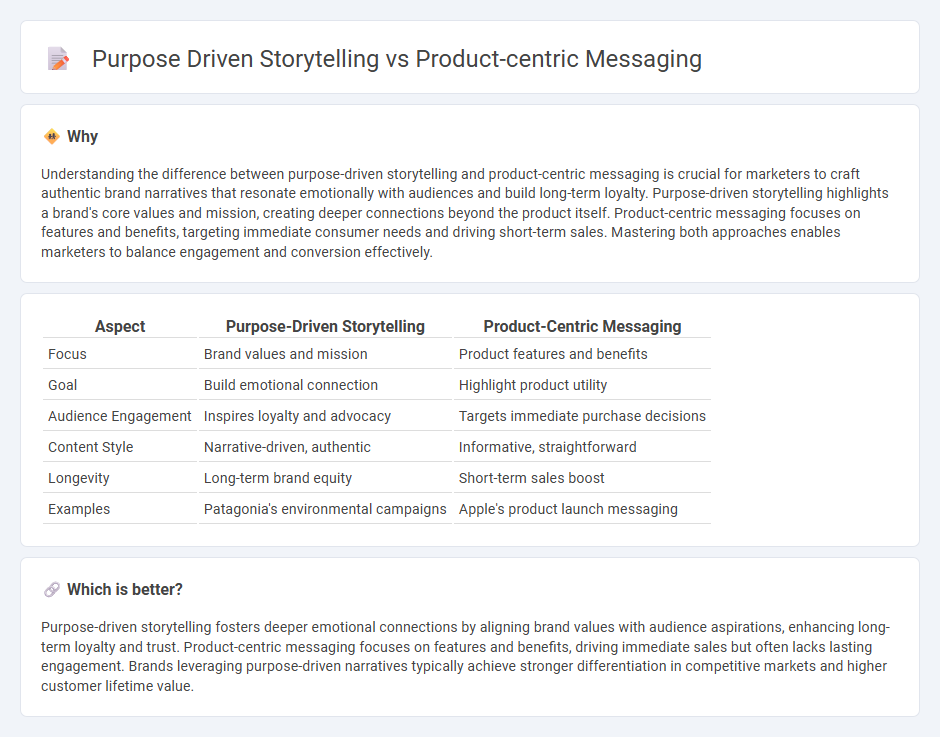
Purpose-driven storytelling connects with audiences by emphasizing brand values and social impact, creating emotional engagement beyond product features. Product-centric messaging focuses primarily on the technical specifications and benefits of the product itself to drive sales. Explore how blending these approaches can amplify your marketing effectiveness and resonate deeper with consumers.
Why it is important
Understanding the difference between purpose-driven storytelling and product-centric messaging is crucial for marketers to craft authentic brand narratives that resonate emotionally with audiences and build long-term loyalty. Purpose-driven storytelling highlights a brand's core values and mission, creating deeper connections beyond the product itself. Product-centric messaging focuses on features and benefits, targeting immediate consumer needs and driving short-term sales. Mastering both approaches enables marketers to balance engagement and conversion effectively.
Comparison Table
| Aspect | Purpose-Driven Storytelling | Product-Centric Messaging |
|---|---|---|
| Focus | Brand values and mission | Product features and benefits |
| Goal | Build emotional connection | Highlight product utility |
| Audience Engagement | Inspires loyalty and advocacy | Targets immediate purchase decisions |
| Content Style | Narrative-driven, authentic | Informative, straightforward |
| Longevity | Long-term brand equity | Short-term sales boost |
| Examples | Patagonia's environmental campaigns | Apple's product launch messaging |
Which is better?
Purpose-driven storytelling fosters deeper emotional connections by aligning brand values with audience aspirations, enhancing long-term loyalty and trust. Product-centric messaging focuses on features and benefits, driving immediate sales but often lacks lasting engagement. Brands leveraging purpose-driven narratives typically achieve stronger differentiation in competitive markets and higher customer lifetime value.
Connection
Purpose-driven storytelling and product-centric messaging intersect by aligning a brand's core values with the tangible benefits of its products, creating a cohesive narrative that resonates deeply with target audiences. This approach enhances emotional engagement and builds trust, as consumers perceive both authenticity and value in the brand's offerings. Integrating compelling stories that highlight purpose alongside clear product features elevates brand loyalty and drives sustained customer acquisition.
Key Terms
Unique Selling Proposition (USP)
Product-centric messaging centers on highlighting the Unique Selling Proposition (USP) by emphasizing specific features, benefits, and differentiators that set the product apart in the market. Purpose-driven storytelling connects the product to broader values and mission-driven narratives, creating emotional resonance and fostering deeper customer loyalty beyond the USP. Explore how blending USP clarity with purposeful storytelling can transform brand engagement and drive sustained growth.
Brand Purpose
Brand purpose centers on conveying a company's core values and mission beyond product features, fostering deeper emotional connections with consumers. Product-centric messaging highlights specific attributes and benefits of offerings, aiming to drive immediate sales through functional appeal. Explore how prioritizing brand purpose can transform customer loyalty and brand perception.
Emotional Connection
Product-centric messaging highlights features and benefits, emphasizing functionality and technical specifications to appeal to consumers seeking practical solutions. Purpose-driven storytelling fosters an emotional connection by aligning brand values with audience aspirations, creating deeper loyalty and advocacy. Discover how integrating emotional resonance can transform your marketing strategy for greater impact.
Source and External Links
How to make your sales messaging more effective - Product-centric messaging evolves from focusing on the seller to making the product the hero, emphasizing features and how the product works to resonate with buyers after product-market fit is found.
Product messaging masterclass - Product messaging translates what a product does into an offer that resonates with the market by focusing on customer problems and needs, ensuring messaging helps customers understand why the product is their solution.
Product-Centric vs. Customer-Centric: Which Wins? - A product-centric approach prioritizes innovation and technical excellence, betting that great products will create their own demand, often involving longer product cycles and major releases ahead of explicit customer requests.
 dowidth.com
dowidth.com